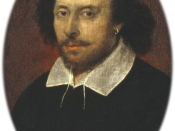William Shakespeare wrote "Richard III" in 1592. He amalgamated his text from a variety of historical records and legends. In doing so, he created a dramatically heightened play and gave Richard, his villainous antihero, intense political and social dimensions. Laurence Olivier adapted the play from the medium of the theatre to film in 1955. It is unusual for Shakespeare's plays to be performed in their entirety. He condensed Shakespeare's text into a coherent script. Olivier used traditional methods of film adaptation, such as cutting characters and dialogue. He did this while maintaining the stereotypes of the characters that were defined by Shakespeare. He concentrated on the main character, Richard, cutting out others. He reordered some of the scenes and added more. He successfully tailored the theme, characterization and style of the play in his representation. Olivier was able to further advance the play's impact by utilizing cinematic techniques and by casting renowned Shakespearean actors to play critical characters.
Olivier starred in the lead as Richard III, Duke of Gloucester. He was fourth in the line for the throne held by his elder brother Edward IV, played by Cedric Hardwicke. Driven by ambition to possess the crown, perhaps as compensation for his deformity, Richard plotted the annihilation of all who stood in his way. This included his brother George, duke of Clarence (John Gielgud), as well as his two young nephews. Richard wis aided in his plots by the corrupt Duke of Buckingham (Ralph Richardson). Even after securing the crown, Richard's cruelty and treachery are not overlooked, and subsequently the kingdom is under siege by Henry of Richmond (Stanley Baker), who claims the crown himself.
The central theme in William Shakespeare's play is the tyranny of Richard III. Although clearly a manipulative genius, Richard's tyranny fuels his...


